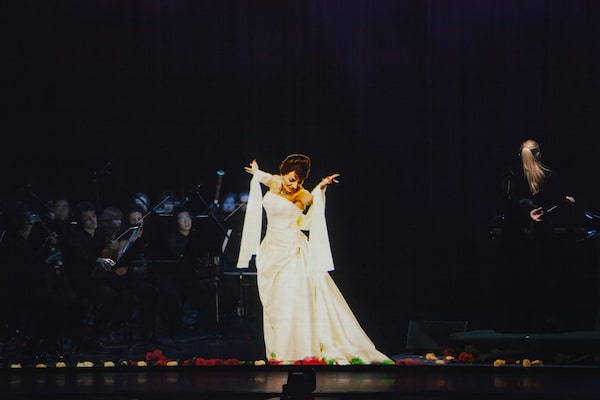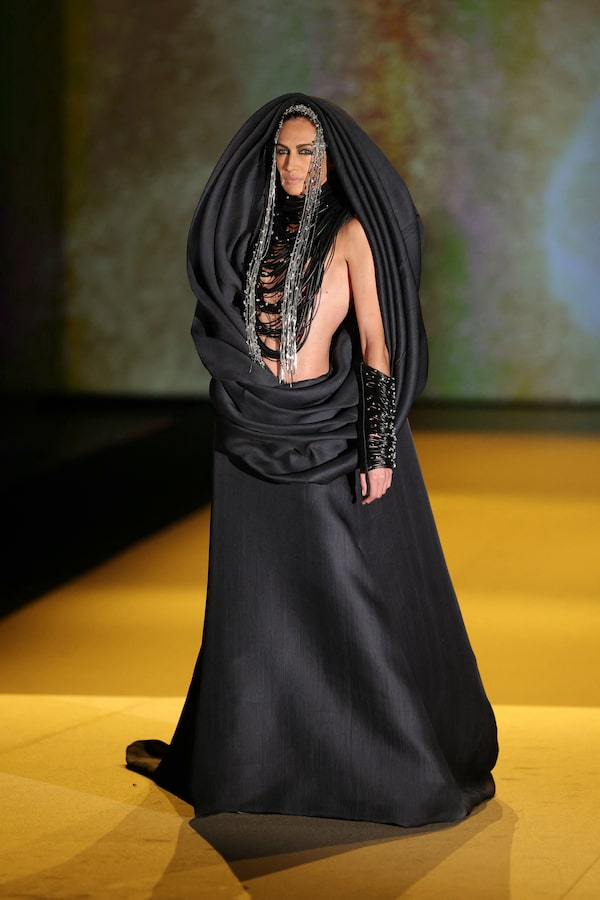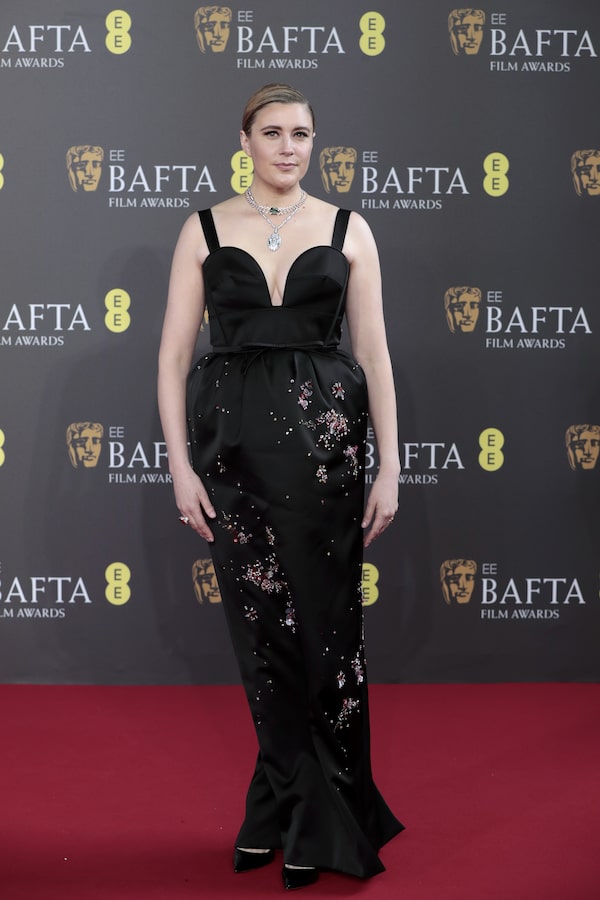
On Feb. 22, 2020, the Vancouver Symphony Orchestra held its first hologram concert with renowned and influential opera singer Maria Callas (who died in 1977) at the Orpheum.Supplied
None of the runways during the Paris haute couture shows this season blended sentiment and spectacle in the way Stéphane Rolland’s did. While key fashion houses picked from mood boards referencing Greek and Roman mythology (Dior), paintings by British artist Lucian Freud (Schiaparelli) or French New Wave cinema of the 1970s (Chanel), Rolland’s fall/winter 2023/2024 collection focused on unravelling the legacy of opera singer Maria Callas.
The American-born Greek singer was known for having a wardrobe that was as dramatic as her career and personal life. (Her much-publicized relationship with Aristotle Onassis famously imploded when she found out he was engaged to Jacqueline Kennedy). And her sartorial savvy, voice and legacy are once again taking the spotlight, and this time a new generation is taking inspiration from her.
Rolland showed long silk dress geometric capes and a fitted jacket created with hand-made petals forged out of porcelain. Many of the runway looks were adorned with grandiose diamond necklaces, inspired by the soprano’s nights of glory at opera houses such as Covent Garden and La Scala. Her gala style was also celebrated via Rolland’s draped coral-red embossed crepe dress.

A model presents a creation for the Stephane Rolland show during the Women's Haute-Couture Spring/Summer 2024 Fashion Week in Paris on Jan. 23.THOMAS SAMSON/Getty Images
Yet the most striking element of his tribute to Callas, who died in 1977 at 53, was his take on a black goddess-like caftan, worn after her much-publicized breakup with Onassis. During their relationship, Callas was not performing on stages as prominently as she did before the pair consciously coupled. Regarded as the closest thing to a revenge dress Callas ever wore, Rolland’s design echoed the singer’s regalia in the 1969 film Medea, Callas’s comeback, her only major movie appearance.
“I was obsessed with the fantasy of Maria Callas climbing up the Palais Garnier stairway once again,” Rolland told FashionNetwork.com, explaining his inspiration, moments before the show began. Appropriately, his models walked to a soundtrack featuring snippets of the soprano’s sweeping arias and sharp soundbites from her outspoken interviews.
At Erdem’s fall 2024 ready-to-wear collection, the Britain-based Canadian designer dedicated 47 looks to the legendary singer. Greta Gerwig wore a Callas-inspired red Balmain gown to the Directors Guild of America Awards and recently donned a bespoke black Erdem outfit for the BAFTAs.

Greta Gerwig attends the 2024 EE BAFTA Film Awards at The Royal Festival Hall on Feb. 18, in London, Eng.John Phillips/Getty Images
This collective and stylish ode to the singer is seizing a moment. A great number of global events, including those organized by the Maria Callas Foundation, acknowledge what would have been the soprano’s centennial year in December, 2023. These include an Australian-based 3-D hologram concerto and an opera project from the Serbian Marina Abramovic celebrating the singer in a multicity European-based tour.
Yet Callas’s spirit will not be facing a curtain call anytime soon. Throughout 2024, several key projects aim to decode the icon, including two key films: Maria Callas: Letters and Memoirs starring Monica Bellucci (a film based on a London and New York stage production) and Angelina Jolie’s much anticipated performance in the coming major motion picture Maria (helmed by Pablo Larrain, who directed Natalie Portman in Jackie).
At the centre of Callas’s rebirth are TikTok and Instagram accounts called the Callas Project, which launched in 2022, although their originators are unknown. While they are as shrouded in mystery as the diva’s own legacy, the accounts have been gaining more traction by the month. As of press time, the Callas Project has 45,000 followers on the two platforms.
A pinned post – which features a clip of an interview with Barbara Walters in 1974 – has won more than five million views on TikTok. Walters asks: “Why don’t you want to get married?’ Callas’s fiery comeback: “Give me one good reason why should I marry? A man has every right to be able to fall in love with someone else – there are no chains for love.”
Her non-conformist views on love and living life on your own terms sync up with social media’s desire to spotlight glory days of the past.
“Of course, modern audiences are drawn to her because social media and opera are all about glorifying the past and looking at who did things first,” explains Toronto-born scholar Matthew Timmermans. The 31-year-old explored the icon’s relevancy in a lecture series for New York’s Metropolitan Opera House during the pandemic. (It sold out, attracting an audience ranging from 20 to 80 years old).
His own curiosity began at age 11, when he began to seek out opera to help him deal with the realization that he was in the closet. He came across a Maria Callas recording at his local library. “I was drawn to opera’s camptastic images and Callas’s story. Both are drag-like in some way,” he says. “I think part of me becoming an opera queen was associating oneself with something over the top.”
About her voice, which is at the centre of her legacy, he explains that her phrasing, breath control and ability to curve, blend, break and intensify the delivery of various notes, created a new standard.
Emerging and established opera singers continue to take notes from Callas, from Vancouver’s Simone Osborne (who has called Callas “a spirit guide”) to Romanian soprano Angela Gheorghiu (the behind-the-scenes video for her 13-year-old album, Homage to Maria Callas, is still racking up YouTube views).
Benedict Gagelmann has spent his life exploring Callas. The 76-year-old German opera devotee recently made news when he donated more than 1,800 pieces to the National Library of Greece, an item list that includes posters from her only film role (Medea), catalogues from auction houses and exhibits as well as books and dissertations from universities around the world.
The gift, says Gagelmann, was meant to inspire a new generation of Callas fans simply because he feels nobody has been able to usurp her. “Her integrity, attitude and intensity are rarely found in our fast-paced world,” he says. “You don’t find this kind of disciplined artist today … and that is what the future needs.”
His donation follows the opening of the Maria Callas Museum in Athens this past December. Visitors can experience the inaugural exhibition – which traces her life through her most legendary performances (Tosca in Covent Garden gets highlighted) and her second career act as a teacher at Julliard. Perhaps more than any other project – past or present – the two-floor shrine is a symbol of the public’s continuing fascination.
“I’m not surprised that fashion and social media is resurrecting her in the way that it has. Few people in history have had a life experience that is as epic, novel-like and cinematic,” says British author Daisy Goodwin, who recently released her book Diva, a deep-dive into the life and style of Callas.
The American-born Greek singer Callas was known for having a wardrobe that was as dramatic as her career and personal life.Courtesy of Sony Pictures Classics
Her research included visiting the opera houses and dressing rooms where Callas once reigned. “Taking singing lessons with a young opera singer proved to be the key insight I needed,” says Goodwin, who also wrote Victoria, about the fabled queen, in addition to producing and writing the series for BBC based on the book. “Learning how to sing brought on a psychological revelation for me. It made me realize that the real tragedy of Maria’s life was not losing Onassis … it was losing her voice,” she explains, referring to Callas’s eventual vocal decline.
About Callas’s status as a style icon, Goodwin says that was a process. “She chose her collaborators carefully and her transformation story was born,” she says. Advisors helped create a goddess look for her that was devoid of florals or mundane patterns. Instead, it basked in regal cuts that mirrored the deities she played on stage.
“She created herself with gay men – people that make divas,” Goodwin says, naming key artistic partners such as theatre and film directors Franco Zeffirelli, Luchino Visconti, Pier Paolo Pasolini and costumer Piero Tosi.
“She and her collaborators understood that every time she would go sing or would be seen in public, she would be going to battle. She was the greatest singer in the world, and she knew it and had the nerve to show it with her clothes and her words,” she says. “That’s why I think so many young people are obsessed with her. That audacity is scarce and so she’s become a heroine decades after her death.”